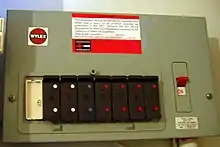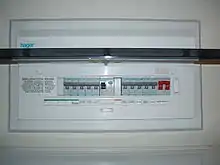| Electrical installations |
|---|
| Wiring practice by region or country |
| Regulation of electrical installations |
| Cabling and accessories |
| Switching and protection devices |


A consumer unit is a type of distribution board (a component of an electrical power system within which an electrical power feed provides supply to subsidiary circuits).
UK
The IET defines a consumer unit, also known as a consumer control unit or electricity control unit, as "a particular type of distribution board comprising a type-tested co-ordinated assembly for the control and distribution of electrical energy, principally in domestic premises, incorporating manual means of double-pole isolation on the incoming circuit(s) and an assembly of one or more fuses, circuit breakers, residual current operated devices or signalling and other devices proven during the type-test of the assembly as suitable for use."[1]
Examples
In the UK, consumer units (CU) have evolved from basic main switch and rewireable fuses, that afforded only overload and short circuit protection, into sophisticated control units housing many safety features that can protect against different types of electrical fault. The choice of circuit protective device will depend upon the type of electrical circuit it is protecting and what level of protection needs to be afforded. BS7671:2018 Requirements for Electrical Installations, also referred to as the IET Wiring Regulations, gets regularly updated and its latest edition at the time of writing is amendment 2:2022 released on 28 March 2022. Typical configurations of CU:
- Main switch consumer unit - Consists of a main switch that will disconnect power to all circuits simultaneously which has one busbar linking all protective devices to a common live source, and one neutral conductor or link bar connecting to a common neutral rail. There will be a separate earth rail to allow the main earth conductor to be connected. This example offers the highest degree of circuit separation as all circuits are independent. This particular example amay not be suitable as a standalone solution with only overload and short circuit protection MCBs for each circuit. Additional protection from earth leakage RCBOs faults and arc faults AFDD may be required by BS7671 making this an expensive solution.
- Main Switch and Dual RCD consumer unit - Consists of a main switch that will disconnect power to all circuits simultaneously and two 30mA RCDs RCDs each with its own live busbar each protecting a separate bank of circuits, typically half-and-half but other combinations are available, from earth leakage faults. Offers a cost-effective solution by using a combination of cheaper mcbs and only two, more expensive, RCDs.
- High integrity consumer unit - Consists of a main switch that will disconnect power to all circuits simultaneously and three separate live busbars, one linked directly to the main switch and two others on each main RCD. The live busbar on the main switch allows the use of mcbs only where more sensitive devices such as RCBOs and AFDDs would not be appropriate, or the independent use of RCBOs, and may be limted to only one or two ways. The remainder of the circuits are divided in the same way as a dual RCD CU. This type of consumer unit offers improved circuit separation over a dual RCD CU whilst allowing for more flexibility.
- RCD incomer consumer unit - This is the least convenient solution in terms of circuit separation because the main switch is an RCD. Less common than the other types, it is no longer considered a standalone solution because power to all circuits is lost in the event of an earth fault causing the main switch RCD to activate.
Modern consumer units are now required to be metal (non-combustible) and usually use DIN-rail mounted devices. The DIN rail is standardized but the busbar arrangements are not. Mixing of different brands devices is against the manufacturers requirements and should generally be avoided.
The choice of consumer unit will reflect several factors such as the size and layout of the dwelling, number of floors, outbuildings, the expected loads (lighting, sockets, ovens, showers, immersion heaters, car-chargers etc.), and how much protection is required for each circuit.
The box pictured top-right is a "Wylex standard" fitted with rewirable fuses. These boxes can also be fitted with cartridge fuses or miniature circuit breakers (MCBs). This type of consumer unit was very popular in Britain until 2001 when wiring regulations mandated residual current device (RCD) protection for sockets that could "reasonably be expected to" supply outdoor equipment (BS 7671:2001, ISBN 0-86341-373-0). There were a number of similar designs from other manufacturers but the Wylex ones are by far the most commonly encountered and the only ones for which fuseholders/breakers are still commonly available.[2]
Some manufacturers have added innovative features such as CPN Cudis who have added a LED strip light to their 'Lumo' consumer unit to enhance visibility in dark locations such as under staircases.[3]
RCD protection types

Since the introduction of (BS 7671:2008 incorporating amendment no 1: 2011) 17th Edition IET Wiring Regulations, consumer units in the UK must provide RCD protection to all cables embedded in walls excepting high integrity circuits such as those for burglar alarms or smoke alarms.
Consumer units have different methods of protecting circuits. For example, a dual split-load consumer unit can be arranged in a two-story dwelling as follows:
RCD 1
- Upstairs Lights,
- Downstairs Ring Final,
- Garage Sockets,
- Cooker
RCD 2
- Downstairs Lights,
- Upstairs Sockets,
- Shower,
- Heating
By arranging the circuits like this, power will still be present on one of the floors if only one RCD trips out. Moreover, having sockets and lights on alternate RCD's means that if a faulty kettle downstairs trips that RCD for example, the kitchen lights will still be available, avoiding the hazard of investigating the fault in darkness.
Another way to protect circuits under the 17th Edition IET Wiring Regulations is by fitting Residual Current Circuit Breaker With Overload (RCBOs) to every circuit, and although this is more costly than the RCD+MCB's option, it means any fault condition on a circuit trips only that circuit's RCBO, so the search for the fault is narrowed down from the start. When an electrician must be called out, this localised fault can be resolved faster (and therefore cheaper) in contrast with the RCD+MCB's arrangement, which only indicates a fault somewhere within that RCD's set of circuits.
Some older systems such as those that use MK or old MEM Consumer Units that had one fuse per spur, so for instance:
- Upstairs Lights Fuse 1
- Upstairs Sockets Fuse 2
- Downstairs Lights Fuse 3
- Downstairs Sockets Fuse 4
etc..
See also
References
- ↑ IET Wiring Regulations Seventeenth Edition - British Standard BS7671:2008, Part 2 Definitions
- ↑ "Google search on UK availability of Modern breakers for older consumer units". Screwfix. Retrieved 5 March 2016.
- ↑ "Innovative Bury company recognised with three award nominations". www.burytimes.co.uk. Retrieved 6 May 2015.
